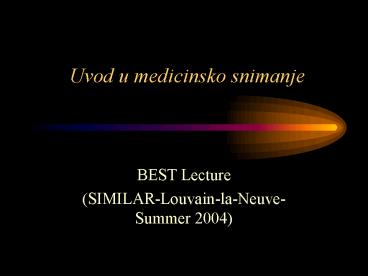Uvod u medicinsko snimanje
1 / 28
Title: Uvod u medicinsko snimanje
1
Uvod u medicinsko snimanje
- BEST Lecture
- (SIMILAR-Louvain-la-Neuve-Summer 2004)
2
Objectives
- Vrste medicinskog snimanja
- rentgensko snimanje
- racunalna tomografija
- snimanje magnetskom rezonancijom
- ultrazvuk
- nuklearna medicina
- Primjena obrade slike u medicini
- Dijagnostika
- Kirurgija vodena slikom
- Otkrivanje droge i funkcijsko snimanje
3
What is medical imaging ?
- Creation of images of structures with the human
body - Applicable to non medical objects
- Elements water (tissue, fluids), bone, air
- Contrast change in signal intensity due to
difference in physical properties - Attenuation, relaxation, refractive index
- Provide information on anatomy and function
4
Examples
5
Generic imaging system
Rf coil, phosphor, scintillation counter, antennae
Detector
Reconstruction Image/signal processing
Source
Storage (PACS)
Nuclear (source is inside)
Xray, rf, ultrasound (energy)
6
Contrast, resolution, SNR
- Contrast
- Ability of distinguish an object from background
(DI/I) - Resolution
- The small distance between two points that can be
imaged - Signal to noise ratio (SNR)
- S/sI, (S measured signal s noise standard
deviation) - Similarly CNR DI/sI
7
Contrast, resolution, SNR
Resolution phantom
SNR phantom (dilution study)
8
Probe characteristics
- Wavelength must be short enough for adequate
resolution. - bone fractures, small vessels lt 1 mm
- large lesions lt 1 cm
- Body should be semi-transparent to the probe.
- transmission gt 10-1 poor contrast
- transmission lt 10 -3 poor signal (SNR)
- wavelength lt 1 cm resolution
- Standard X-rays .01 Å lt ? lt .5 Å
- 25 Kev to 1.0 Mev per photon
9
EM probes
- Probes
- Xray (Mammography, CT) XR 0-30s CT 70s
- Magnetic field (MRI) 80s-90s
- Sound waves (Ultrasound) 60s
- Photon/Positrons (PET, SPECT) 80s
- Infrared, optical current research
- Differing characteristics
- Xray-gt no diffraction US -gt diffraction
- Internal vs. external source
- Toxic vs. non toxic
- Invasive vs. non invasive
10
Xrays
- Cheap, portable
- Collapsed image (projection) gt loss of depth
info - Distortion due to point source, magnification
etc.
11
Xray developments (early 20th c)
Use of intravenous agents (e.g. I, Ba) to enhance
contrast Subtraction of non contrast with
contrast (digital subtraction angiography) Real
time imaging or fluoroscopy
Barium (enema) fluoro
12
Tomography (Gr tomos section)
First generation CT scanner Record signal for
each beam and translate Rotate the
source-detector setup and repeat Back projection
to get m(x,y)
Fourth generation CT scanner Fan beam Detector
rings
13
CT (contd)
Heart scan Brain trauma Liver scan
(tumor)
- Good contrast, depth resolution
- Axial slices only, Radiation exposure
14
- Ultrasound uses the transmission and reflection
of acoustic energy.
? prenatal ultrasound image ?clinical
ultrasound system
15
Ultrasound
- A pulse is propagated and its reflection is
received, - both by the transducer.
- Key assumption
- - Sound waves have a nearly constant velocity
- of 1500 m/s in H2O.
- - Sound wave velocity in H2O is similar to that
in soft tissue. - Thus, echo time maps to depth.
16
US resolution vs. attenuation
- Typical Ultrasound Frequencies
- Deep Body 1.5 to 3.0 MHz
- Superficial Structures 5.0 to 10.0 MHz
- e.g. 15 cm depth, 2 MHz, 60 dB round trip
17
Ultrasound
Gallstone
Colour doppler of portal vein
Heart scan using US
18
Nuclear medicine
- Uses radio-pharmaceuticals (radioisotopes) like
Technetium or labelled Glucose which are g
emitters - Injected or inhaled or ingested
- Information about function as these isotopes
enter the metabolic pathways e.g. thyroid takes
up Iodine or bones take up Strontium - Detector is a gamma camera (Anger camera) uses CT
methods - SPECT (Single Photon Emission CT)
- PET (Positron emission tomography)
19
Gamma camera
Thyroid SPECT
20
Nuclear medicine
Brain PET (FDG) with tumour
Bone scan (Tc-Phosphate)
Thyroid SPECT
21
Magnetic Resonance
- Any particle with a net spin possesses a magnetic
moment vector (acts like a tiny magnet) - Magnetic moment in an external magnetic field B0
is like a top in a gravitational field - Force applied to spinning objects results in a
net perpendicular force precession - Precession (Larmor) Frequency is gBo 63MHz for
1H
Bo
m
22
Spin in B0
m
N
S
Anti-parallel (high)
DE hgB0
Energy
Bo
Parallel (low)
Bo
When a spin is placed in a magnetic field it
assumes a parallel or anti-parallel configuration
23
Ensemble of spins in Bo
- Slight excess of parallel over anti-parallel
spins resulting in a net magnetic moment M
oriented along B0 - Application of another perpendicular magnetic
field B1 results in tipping of M due to
precession of M about (B0 B1) - Removal of B1 will cause slow recovery to
equilibrium while still precessing about B0 - A loop of wire (coil) will pick up a voltage due
to the varying magnetic field
24
B1 excitation
z
z
Bo
Bo
? gB1t
M
?
M
y
y
B1
x
x
Image courtesy Physics of Diagnostic Radiology,
Christensen
25
MRI systems
- 0.3 T permanent magnet
3 T superconducting magnet
26
MRI
Brain tumor
Spine herniated disc (C4)
Long axis movie of heart
Knee with torn ACL/hematoma
27
Comparison
28
Nobel Prizes
- Roentgen (1901, Xrays)
- Bragg(s) (1915, Xray energy levels)
- Hounsfield, Cormack (1979, CT)
- Rabi (1944, MR)
- Bloch et al. (1952, MR)
- Ernst (1991, NMR)
- Wuthrich (2002, NMR)
- Lauterbur, Mansfield (2003, MRI)

